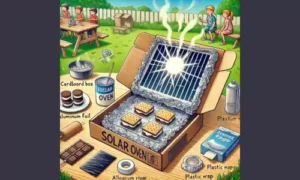Recently updated on December 4th, 2024 at 06:12 am
Introduction
Seventh grade is a vital period for kids to improve their understanding of STEM courses, encourage creativity, and develop problem-solving skills. Incorporating hands-on activities into the curriculum can significantly improve their learning experience. In this blog, we’ll look at several STEM activities intended exclusively for seventh-grade students, to engage their minds and spark a passion for inquiry.
1. Create a solar oven

Objective: To introduce students to the fundamentals of solar energy and its uses.
Materials Required: A cardboard box, aluminium foil, plastic wrap, black construction paper, tape, scissors, a thermometer, and cooking ingredients.
Activity: Students work in groups to construct solar ovens out of the materials provided. They create and test various setups to optimize heat absorption. Once built, they utilize their ovens to prepare a variety of foods, noting the efficiency of solar energy in cooking.
2. Coding with Micro: bit

Objective: Introduce basic coding concepts and computational thinking through hands-on programming.
Materials Needed: BBC Micromicrocontrollers, computers or tablets with USB ports, internet access.
Activity: Students are introduced to the Microplatform and guided through simple coding exercises. They learn to program the device to display messages, create simple games, and interact with sensors. As they progress, they tackle more complex challenges, fostering problem-solving skills and computational thinking.
3. Pasta Bridge Engineering

Objective: Build and test spaghetti bridges to learn about structural engineering fundamentals.
Materials Needed: Materials required include various types of pasta (spaghetti, linguine, etc.), white glue, rulers, weights (books, coins), and tape.
Activity: Students work independently or in small groups to design and create bridges out of pasta and glue. They experiment with various bridge designs, taking into account span length, load-bearing capability, and structural stability. Once built, bridges are tested by gradually adding weights until they collapse, allowing students to assess the success of their designs.
4. Chemical Reaction

Objective: Use entertaining experiments to introduce students to basic chemistry topics.
Materials Required: Safety goggles, baking soda, vinegar, food colouring, balloons, test tubes, measuring spoons, and cups.
Activity: Students perform a sequence of elementary chemical reactions, including the famous baking soda and vinegar reactions. They observe the production of gas bubbles and talk about the underlying chemical processes. They can also investigate the consequences of adding new compounds or changing the reaction circumstances, which promotes critical thinking and hypothesis testing.
Also See: STEM Activities for 8th grade kids
5. Robotics Challenge

Objective: Use a fun challenge to introduce students to robotics fundamentals and programming.
Materials Required: LEGO Mindstorms EV3 kits, PCs, or tablets running EV3 software.
Activity: Students work in groups to program LEGO robots to fulfil a specified goal, such as navigating a maze or picking up objects. They learn how to program the robots with the EV3 software, including topics like sensors, loops, and conditional statements. They get successful results by iteratively designing and testing their programs.
Conclusion
Engaging seventh graders in STEM activities strengthens their comprehension of basic ideas while also developing critical thinking, problem-solving, and collaborative skills. Educators may foster a lifetime interest in STEM subjects in kids by adding hands-on, inquiry-based activities into the curriculum, empowering them to become tomorrow’s innovators and problem solvers.






